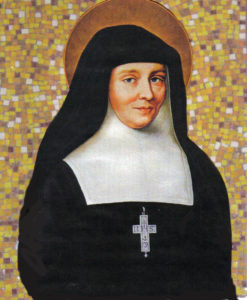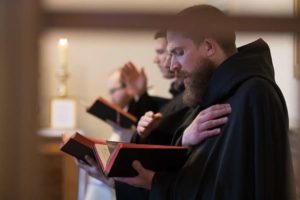On Carmel’s Height, Day & Night,
Someone prays for you
By Sr. Clare Joseph, O.C.D.
Celebration of our Foundation

On October 8, 2022, a day after our actual Foundation Day on the Feast of the Most Holy Rosary, our community will mark the 75th Jubilee year since our foundation from the Carmelite monastery in Indianapolis, Indiana, in 1947. We will honor this joyful event with the Holy Sacrifice of the Mass. Our Archbishop Charles Thompson will preside while several of our Carmelite friars will join him to concelebrate. Pending the COVID restrictions, we hope to make it a public event where all are invited to join us in this jubilant celebration.
Our Beginnings
 Before our foundation was made from the Indianapolis Carmel, the Archbishop of Indianapolis, Archbishop Joseph Ritter, dreamed of having a Carmelite community in Terre Haute praying. The city had become infiltrated with corruption and crime and Archbishop Ritter longed to have nuns right in Terre Haute, praying that the city would once again become a wholesome place for people to live and raise their families. And so, it was Archbishop Ritter who planted the first seed for our foundation. When we moved here on October 7, 1947, we lived in a house on the property and, with the help of friends, our monastery was gradually built, stage by stage.
Before our foundation was made from the Indianapolis Carmel, the Archbishop of Indianapolis, Archbishop Joseph Ritter, dreamed of having a Carmelite community in Terre Haute praying. The city had become infiltrated with corruption and crime and Archbishop Ritter longed to have nuns right in Terre Haute, praying that the city would once again become a wholesome place for people to live and raise their families. And so, it was Archbishop Ritter who planted the first seed for our foundation. When we moved here on October 7, 1947, we lived in a house on the property and, with the help of friends, our monastery was gradually built, stage by stage.
Growth
“Just as they were leaving him, Peter said to Jesus, “Master, it is good for us to be here; let us make three tents, one for you, one for Moses, and one for Elijah” (Luke 9:33).
Fast forward 75 years, our firmly planted seeds have taken root as we have grown into the contemplative community that we are today here in Terre Haute, Indiana. God has watered the seeds and provided the growth, blessing us in abundance.
 Our current monastery stands on a hill overlooking Terre Haute, the city that we love and which we pray. Our chapel roof is distinguished by three peaks, representative of the three tents that Peter wanted to make for Jesus, Moses, and Elijah. Over the years we were able to acquire the property adjacent to our original plot of land. This allows us to cultivate gardens and an orchard, which provide us with fruit and vegetables throughout the year. The additional grounds also provide us opportunity to pray and encounter God in nature.
Our current monastery stands on a hill overlooking Terre Haute, the city that we love and which we pray. Our chapel roof is distinguished by three peaks, representative of the three tents that Peter wanted to make for Jesus, Moses, and Elijah. Over the years we were able to acquire the property adjacent to our original plot of land. This allows us to cultivate gardens and an orchard, which provide us with fruit and vegetables throughout the year. The additional grounds also provide us opportunity to pray and encounter God in nature.
Gratitude to overflowing
 Our hearts are filled with gratitude for the great and loving support we have received from our families, many friends, and benefactors. Their help has come to us in a variety of ways, from our building days to our current reality and day to day needs. No sooner do we have a need, offer prayers to God, then we receive a phone call or knock on the door from one of our numerous friends, offering their support, eager for the opportunity to “pay us back” for praying for their needs. Words cannot express our gratitude for all the assistance and support we have received over the years.
Our hearts are filled with gratitude for the great and loving support we have received from our families, many friends, and benefactors. Their help has come to us in a variety of ways, from our building days to our current reality and day to day needs. No sooner do we have a need, offer prayers to God, then we receive a phone call or knock on the door from one of our numerous friends, offering their support, eager for the opportunity to “pay us back” for praying for their needs. Words cannot express our gratitude for all the assistance and support we have received over the years.
 Significantly, our sisters from the Indianapolis Carmel – the community that we were founded from – have overwhelmed us with their ongoing support and generosity. Although they are few in number and have relocated to Oldenburg, Indiana, to the campus of the Franciscan community, they are closer to us than ever before, in heart and in our united prayers.
Significantly, our sisters from the Indianapolis Carmel – the community that we were founded from – have overwhelmed us with their ongoing support and generosity. Although they are few in number and have relocated to Oldenburg, Indiana, to the campus of the Franciscan community, they are closer to us than ever before, in heart and in our united prayers.
“… chosen and precious in God’s sight, and like living stones, let yourselves be built into a spiritual house, to be a holy priesthood, to offer spiritual sacrifices acceptable to God through Jesus Christ” (1Peter 2:4-5) .
 We are especially proud and grateful for the community that we have become and are becoming. In addition to the unique treasure that each sister is, the cultures of our international community of sisters further enriches our common life. We share and sincerely experience the joys of life in community with one another, making real Our Holy Mother St. Teresa’s desire that in our communities: “… all must be friends, all must be loved, all must be held dear, all must be helped” (The Way of Perfection, 4:7). It is our “living stones” that we cherish most of all – one another!
We are especially proud and grateful for the community that we have become and are becoming. In addition to the unique treasure that each sister is, the cultures of our international community of sisters further enriches our common life. We share and sincerely experience the joys of life in community with one another, making real Our Holy Mother St. Teresa’s desire that in our communities: “… all must be friends, all must be loved, all must be held dear, all must be helped” (The Way of Perfection, 4:7). It is our “living stones” that we cherish most of all – one another!
Mostly, our gratitude is to God for God Himself; for His fidelity, His love, His peace, His sustaining and providing for us, our Church, and our whole world in every way; for loving “the world so much that He gave His only Son.” (John 3:16). Every momentous anniversary of our monastery is an opportunity for us to recall with profound gratitude and awe the graciousness with which God has smiled upon us from our first years in Terre Haute.
 Our Vision Statement reads that “we are consecrated women of the Teresian Carmel, living in sisterly communion, holding the lamp of contemplation ‘till we become a living flame of love.’”
Our Vision Statement reads that “we are consecrated women of the Teresian Carmel, living in sisterly communion, holding the lamp of contemplation ‘till we become a living flame of love.’”
We believe that this flame of love has a continual and tremendous spiritual influence in our world, beyond the parameters of Terre Haute, Indiana, even while it may be hidden from our eyes. It is the Spirit of God moving all over our world that brings life and hope and this is what we have dedicated our lives to here on the mount in Terre Haute, Indiana.
“… and hope does not disappoint us, because God’s love has been poured into our hearts through the Holy Spirit that has been given to us” (Romans 5:5).
Visit: heartsawake.org


























